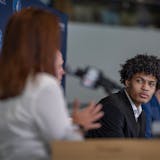VERGAS, Minn. — "Can I get a few Mickeys for a young kid like you?" said the silver-haired volunteer behind the griddle, flipping a pancake shaped like the Disney mouse. A man of roughly the same vintage holds out his plate, smiling at the joke.
It's not even 9 a.m., and the line for Vergas' annual Maple Syrup Fest pancake feed is already out the door. Soon it will snake down the block. Not a bad turnout for a town of 355 people in the heart of western Minnesota's lake country.
A guy with a goatee, casually dressed in jeans and a sweatshirt, walks among the tables introducing himself. He's Erik Osberg, Rural Rebound Initiative Coordinator — presumably the only person in the country with that title — for Otter Tail County. Wielding two cameras, Osberg documents the event, making it look as appealing as syrup poured on a hotcake.
As the packed hall would suggest, and much data attests, reports of rural life's demise are greatly exaggerated.
Following a steady decline in population, rural areas in the U.S. grew 11% from 1970-2010 before leveling off. According to Pew and Gallup polls, roughly half of all Americans say their ideal place to live is a small town or rural area. Gen Xers and millennials have been acting on that preference, as the population of 30- to 49-year-olds has increased in rural communities, countering the so-called "brain drain" of those who depart after high school.
Minnesota is a leader in capitalizing on this rural resurgence, launching many recruitment initiatives around the state even before the rise of remote work made moving to the country more viable. Otter Tail County's approach — Osberg's turning social media into a vision board of an aspirational lifestyle — is among the best resourced and most innovative.
Since 2017, Osberg has been posting, often several times a day, about local restaurants, resorts and community events; he passes along home listings; he shares scenes of bonfires and sunsets and serenading trumpeter swans. The sum of these "micro-stories," Osberg says, creates a larger narrative: You can live the good life in rural Minnesota.
Last fall, Osberg took a deeper look at the local lifestyle by producing a video series called "Rural by Choice," hosted by Twin Cities broadcaster Cory Hepola. In it, the millennial dad returns to his roots in Otter Tail County to explore why people like living in rural communities — and busts a few myths in the process.


